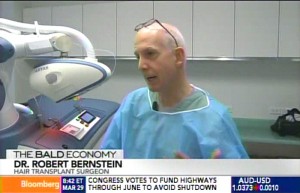Dr. Bernstein spoke with Bloomberg’s Matt Miller about the future of hair transplantation in a segment called, “The Bald Economy: Surgical Solutions to Hair Loss.”
Here is an excerpt from the segment:
Bloomberg’s Matt Miller: Riding the wave into the future happens to be one of the pioneers of FUE, Dr. Robert Bernstein.
Dr. Bernstein: “The robot now allows a mechanized system to do [follicular unit extraction] very, very quickly and very consistently, so that the human error in this part of the procedure is now gone.”
Matt Miller: That’s right, a robot. Dr. Bernstein is piloting a high-tech solution called ARTAS.
Dr. Bernstein: “What it is very precise at doing is getting around the follicular unit to separate it from the tissue.”
Matt Miller: The procedure, which costs twice as much as the standard surgery, has one clear advantage.
Dr. Bernstein: “The difference is, in the back, in the area where we take the hair, there will be little tiny dots that just fade into the scalp.”
Read more about the ARTAS Robot for FUE and Robotic Hair Transplantation
Posted by






